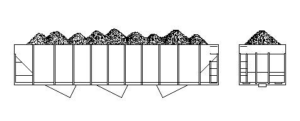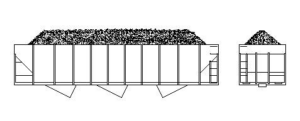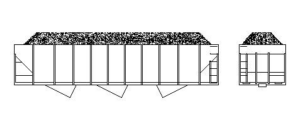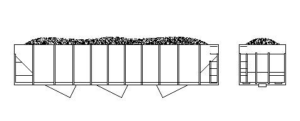by Dan Bourque
In ABCs of Coal Loaders, we learned about the different types of loaders used to load coal cars. Now let’s do a study of how the type of loader affects the appearance of the coal load.
When most of us think of coal loads, we think of the gently sloped and slightly humped pile of black stuff rising just barely over the top of the car. If you’re modeling a coal train far, far away from its loading point, this type of load is perfect. However, if you’re modeling the Appalachians, chances are you’re going to have a loader or two on your layout. For those of you in this category, you have to pay a little more attention to the prototype.
Truck Dump Loads
 Let’s start with the truck dump loader, as it produces some of the most distinct loads. Most truck dump operations are small and simple, so their method of moving a car must be equally simple. Many loaders are built on a grade so gravity can do a lot of work for them. Invariably, empty hoppers are placed upgrade of the loading point. When it’s time to load the car, someone hops onto the car, releases the handbrakes, and coasts the end of the car underneath the loader. The coal is then loaded into the hopper until it is literally spilling over the sides. At this point, the car is coasted a few feet further under the loader and a new pile is made next to the first. After several iterations of this process, the car looks like a camel with ten or so humps along its back. In places where there’s not enough of a grade to move the cars, the loading crew may attach a cable winch to the car and pull it under the loader instead. Some operations even use a front-end loader to push the cars into place (ever wonder why so many hoppers have bent and twisted ladders at the ends?)
Let’s start with the truck dump loader, as it produces some of the most distinct loads. Most truck dump operations are small and simple, so their method of moving a car must be equally simple. Many loaders are built on a grade so gravity can do a lot of work for them. Invariably, empty hoppers are placed upgrade of the loading point. When it’s time to load the car, someone hops onto the car, releases the handbrakes, and coasts the end of the car underneath the loader. The coal is then loaded into the hopper until it is literally spilling over the sides. At this point, the car is coasted a few feet further under the loader and a new pile is made next to the first. After several iterations of this process, the car looks like a camel with ten or so humps along its back. In places where there’s not enough of a grade to move the cars, the loading crew may attach a cable winch to the car and pull it under the loader instead. Some operations even use a front-end loader to push the cars into place (ever wonder why so many hoppers have bent and twisted ladders at the ends?)
Tipple Loads
 Tipple loads vary from tipple to tipple. In many tipples, the car loading process is identical to the truck dump, so the cars have distinctive humps, albeit with different sizes of coal comprising the humps depending on which track the car was loaded on (remember different tracks=different sized coal). Many other tipples, however, have movable chutes to load the coal. With a movable chute, the car is placed under the loader. The chute operator then positions the chute over one end of the car and starts loading. As one end of the car fills up, the chute moves down the car to fill it uniformly from end to end. Like the truck dump, they usually load to the brim producing a tall, highly sloped ridge along the center of the car.
Tipple loads vary from tipple to tipple. In many tipples, the car loading process is identical to the truck dump, so the cars have distinctive humps, albeit with different sizes of coal comprising the humps depending on which track the car was loaded on (remember different tracks=different sized coal). Many other tipples, however, have movable chutes to load the coal. With a movable chute, the car is placed under the loader. The chute operator then positions the chute over one end of the car and starts loading. As one end of the car fills up, the chute moves down the car to fill it uniformly from end to end. Like the truck dump, they usually load to the brim producing a tall, highly sloped ridge along the center of the car.
Flood Loads
 Unlike truck dumps and tipples, flood loaders are a lot more precise. In a typical modern flood loader, the cars are loaded using the train’s motive power as the moving force. To make things easy, most cars in a flood-loaded unit train are identical or at least very similar so the train crew simply has to maintain a specific speed (usually a crawl) through the loader to get the right amount of coal in each car. As a result, flood loads are very uniform throughout the train. In a lot of cases, the loads will take on a very geometric shape with sloped sides and a sqare, flat top caused by the bottom of the loader scraping the top of the load level.
Unlike truck dumps and tipples, flood loaders are a lot more precise. In a typical modern flood loader, the cars are loaded using the train’s motive power as the moving force. To make things easy, most cars in a flood-loaded unit train are identical or at least very similar so the train crew simply has to maintain a specific speed (usually a crawl) through the loader to get the right amount of coal in each car. As a result, flood loads are very uniform throughout the train. In a lot of cases, the loads will take on a very geometric shape with sloped sides and a sqare, flat top caused by the bottom of the loader scraping the top of the load level.
“On the Road” Loads
 As a train travels farther and farther from its loading point, the shaking and bumping of the car make their effect known on the coal load. The jolts and jostles cause the load to settle. Peaks start flattening, and a once heaping load settles down below the top of the hopper until after a hundred miles or so, it’s nearly impossible to tell what kind of loader the coal came from. The best advice on how to determine which kinds of loads are right for your layout is to study pictures of the area. You may find several different varieties of loads all on one train! Don’t worry, all of these types of loads are easy to model, but that’s a subject for a different article.
As a train travels farther and farther from its loading point, the shaking and bumping of the car make their effect known on the coal load. The jolts and jostles cause the load to settle. Peaks start flattening, and a once heaping load settles down below the top of the hopper until after a hundred miles or so, it’s nearly impossible to tell what kind of loader the coal came from. The best advice on how to determine which kinds of loads are right for your layout is to study pictures of the area. You may find several different varieties of loads all on one train! Don’t worry, all of these types of loads are easy to model, but that’s a subject for a different article.
Related Products:





Pingback: ABCs of Coal Loaders – Appalachian Railroad Modeling